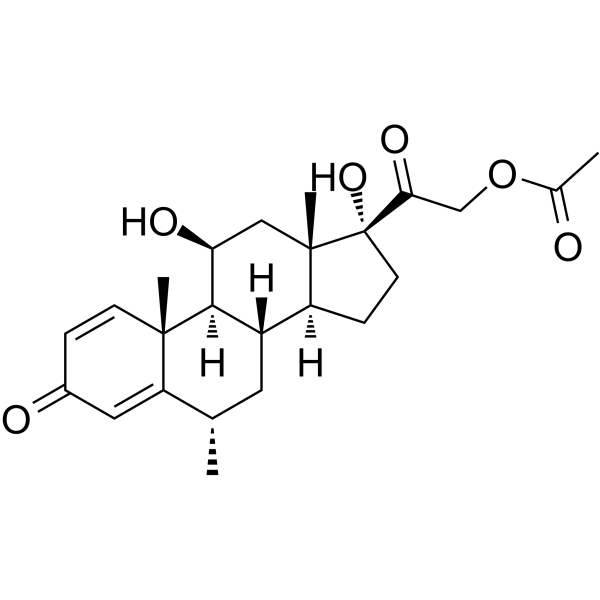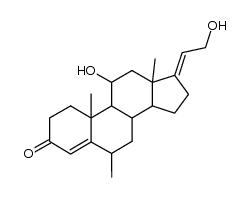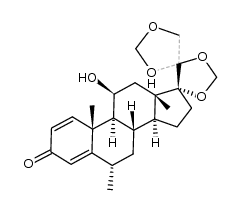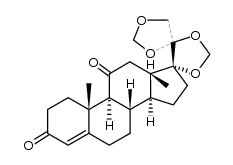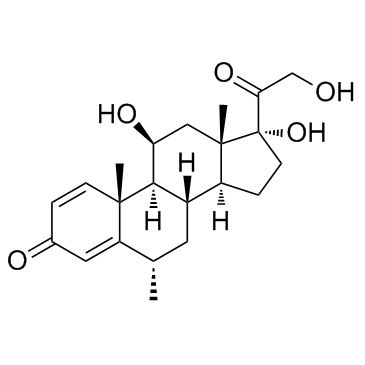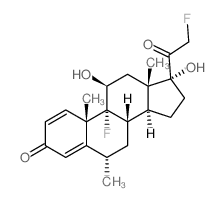53-36-1
| 中文名 | 醋酸甲泼尼龙 |
|---|---|
| 英文名 | methylprednisolone acetate |
| 中文别名 |
6A-甲基泼尼松龙醋酸酯
甲基强的龙醋酸盐 6Alpha-甲基波尼松龙21-醋酸 甲基泼尼松龙醋酸酯 |
| 英文别名 |
2-[(6S,8S,9S,10R,11S,13S,14S,17R)-11,17-Dihydroxy-6,10,13-trimethyl-3-oxo-6,7,8,9,10,11,12,13,14,15,16,17-dodecahydro-3H-cyclopenta[a]phenanthren-17-yl]-2-oxoethylacetat
6-METHYLPREDNISOLONE ACETATE (6α,11β)-11,17-Dihydroxy-6-methyl-3,20-dioxopregna-1,4-dien-21-yl acetate Methylprednisolone acetate 21-Acetoxy-11b,17-dihydroxy-6a-methylpregna-1,4-diene-3,20-dione (6a,11b)-21-(Acetyloxy)-11,17-dihydroxy-6-methylpregna-1,4-diene-3,20-dione 6a-Methylprednisolone 21-Acetate CH3CO2CH(CH3)CH2OCH3 Depo-methylprednisolone MFCD00144786 EINECS 200-171-3 Pregna-1,4-diene-3,20-dione, 21-(acetyloxy)-11,17-dihydroxy-6-methyl-, (6α,11β)- 2-[(6S,8S,9S,10R,11S,13S,14S,17R)-11,17-dihydroxy-6,10,13-trimethyl-3-oxo-6,7,8,9,10,11,12,13,14,15,16,17-dodecahydro-3H-cyclopenta[a]phenanthren-17-yl]-2-oxoethyl acetate acétate de 2-[(6S,8S,9S,10R,11S,13S,14S,17R)-11,17-dihydroxy-6,10,13-triméthyl-3-oxo-6,7,8,9,10,11,12,13,14,15,16,17-dodécahydro-3H-cyclopenta[a]phénanthrén-17-yl]-2-oxoéthyle 6α-Methyl Prednisolone 21-Acetate 6α-Methylprednisolone 21-acetate Solsolona Pregna-1,4-diene-3,20-dione, 11β,17,21-trihydroxy-6α-methyl-, 21-acetate (8CI) |
| 描述 | 醋酸甲基强的松龙是一种强的松酮衍生物,是一种皮质类固醇激素。醋酸甲基强的松龙可减轻关节炎和其他关节疾病在体内引起的疼痛和肿胀[1][2]。 |
|---|---|
| 相关类别 | |
| 体内研究 | 醋酸甲基强的松龙(30mg/kg,肌肉注射;连续10天额外口服剂量为13mg/kg)与LPS联合诱导股骨头早期AVN的典型特征[2]。动物模型:甲基强的松龙和脂糖诱导的小鼠股骨头坏死模型[2]剂量:30mg/kg;13mg/kg,连续10天给药:30mg/kg,肌肉注射;连续10天口服13mg/kg的额外剂量会导致7周后软骨细胞变性和纤维软骨表达。增加股骨头中CD31和VEGF-R2标记物的密度。 |
| 参考文献 |
| 密度 | 1.3±0.1 g/cm3 |
|---|---|
| 沸点 | 582.5±50.0 °C at 760 mmHg |
| 熔点 | 206ºC |
| 分子式 | C24H32O6 |
| 分子量 | 416.507 |
| 闪点 | 196.5±23.6 °C |
| 精确质量 | 416.219879 |
| PSA | 100.90000 |
| LogP | 3.08 |
| 外观性状 | 灰白色固体 |
| 蒸汽压 | 0.0±3.7 mmHg at 25°C |
| 折射率 | 1.580 |
| 储存条件 | Refrigerator |
| 分子结构 | 1、 摩尔折射率:109.67 2、 摩尔体积(cm3/mol):329.3 3、 等张比容(90.2K):893.5 4、 表面张力(dyne/cm):54.1 5、 极化率(10-24cm3):43.47 |
| 计算化学 | 1.疏水参数计算参考值(XlogP):无 2.氢键供体数量:2 3.氢键受体数量:6 4.可旋转化学键数量:4 5.互变异构体数量:6 6.拓扑分子极性表面积101 7.重原子数量:30 8.表面电荷:0 9.复杂度:858 10.同位素原子数量:0 11.确定原子立构中心数量:8 12.不确定原子立构中心数量:0 13.确定化学键立构中心数量:0 14.不确定化学键立构中心数量:0 15.共价键单元数量:1 |
|
Section 1. Chemical Product and Company Identification Methylprednisolone acetateCatalog ME171 Common Name/ Number(s). Trade Name CAS#53-36-1
Manufacturer RTECSTU4154050 SPECTRUM CHEMICAL MFG. CORP. TSCATSCA 8(b) inventory: Methylprednisolone acetate Commercial Name(s)Not available. CI# Not available. Synonym11,17,21-Trihydroxy-6-methyl-1,4-pregnadiene-3,20-dione acetate IN CASE OF EMERGENCY Not available. Chemical Name Chemical FamilyNot available.CALL (310) 516-8000 C24H32O6 Chemical Formula SPECTRUM CHEMICAL MFG. CORP. Section 2.Composition and Information on Ingredients Exposure Limits TWA (mg/m3)STEL (mg/m3) CEIL (mg/m3) NameCAS #% by Weight 1) Methylprednisolone acetate53-36-1100 Toxicological DataMethylprednisolone acetate on IngredientsLD50: Not available. LC50: Not available. Section 3. Hazards Identification Potential Acute Health Effects Hazardous in case of skin contact (irritant, permeator), of eye contact (irritant), of ingestion, of inhalation. Potential Chronic HealthHazardous in case of skin contact (irritant, permeator), of eye contact (irritant), of ingestion, of inhalation. EffectsCARCINOGENIC EFFECTS: Not available. MUTAGENIC EFFECTS: Not available. TERATOGENIC EFFECTS: Not available. DEVELOPMENTAL TOXICITY: Not available. Methylprednisolone acetate Section 4. First Aid Measures Eye ContactCheck for and remove any contact lenses. Do not use an eye ointment. Seek medical attention. Skin ContactAfter contact with skin, wash immediately with plenty of water. Gently and thoroughly wash the contaminated skin with running water and non-abrasive soap. Be particularly careful to clean folds, crevices, creases and groin. Cover the irritated skin with an emollient. If irritation persists, seek medical attention. Wash contaminated clothing before reusing. Serious Skin ContactWash with a disinfectant soap and cover the contaminated skin with an anti-bacterial cream. Seek medical attention. InhalationAllow the victim to rest in a well ventilated area. Seek immediate medical attention. Serious InhalationNot available. IngestionDo not induce vomiting. Loosen tight clothing such as a collar, tie, belt or waistband. If the victim is not breathing, perform mouth-to-mouth resuscitation. Seek immediate medical attention. Serious IngestionNot available. Section 5. Fire and Explosion Data Flammability of the Product May be combustible at high temperature. Auto-Ignition Temperature Not available. Flash PointsNot available. Flammable LimitsNot available. These products are carbon oxides (CO, CO2). Products of Combustion Fire Hazards in Presence of Not available. Various Substances Explosion Hazards in Presence Risks of explosion of the product in presence of mechanical impact: Not available. of Various SubstancesRisks of explosion of the product in presence of static discharge: Not available. Fire Fighting MediaSMALL FIRE: Use DRY chemical powder. and InstructionsLARGE FIRE: Use water spray, fog or foam. Do not use water jet. Special Remarks onNot available. Fire Hazards Special Remarks on Explosion Not available. Hazards Section 6. Accidental Release Measures Small SpillUse appropriate tools to put the spilled solid in a convenient waste disposal container. Finish cleaning by spreading water on the contaminated surface and dispose of according to local and regional authority requirements. Large Spill Use a shovel to put the material into a convenient waste disposal container. Finish cleaning by spreading water on the contaminated surface and allow to evacuate through the sanitary system. Methylprednisolone acetate Section 7. Handling and Storage PrecautionsKeep away from heat. Keep away from sources of ignition. Empty containers pose a fire risk, evaporate the residue under a fume hood. Ground all equipment containing material. Do not breathe dust. Wear suitable protective clothing In case of insufficient ventilation, wear suitable respiratory equipment If you feel unwell, seek medical attention and show the label when possible. Avoid contact with skin and eyes StorageKeep container dry. Keep in a cool place. Ground all equipment containing material. Keep container tightly closed. Keep in a cool, well-ventilated place. Combustible materials should be stored away from extreme heat and away from strong oxidizing agents. Section 8. Exposure Controls/Personal Protection Engineering ControlsUse process enclosures, local exhaust ventilation, or other engineering controls to keep airborne levels below recommended exposure limits. If user operations generate dust, fume or mist, use ventilation to keep exposure to airborne contaminants below the exposure limit. Personal ProtectionSplash goggles. Lab coat. Dust respirator. Be sure to use an approved/certified respirator or equivalent. Gloves. Personal Protection in Case of Splash goggles. Full suit. Dust respirator. Boots. Gloves. A self contained breathing apparatus should be used a Large Spillto avoid inhalation of the product. Suggested protective clothing might not be sufficient; consult a specialist BEFORE handling this product. Exposure LimitsNot available. Section 9. Physical and Chemical Properties Physical state and appearance Solid. (Crystalline solid.)OdorNot available. TasteNot available. 416.51 g/mole Molecular Weight ColorWhite. pH (1% soln/water)Not applicable. Boiling PointDecomposes. Melting Point206°C (402.8°F) Critical TemperatureNot available. Specific GravityNot available. Not applicable. Vapor Pressure Vapor DensityNot available. VolatilityNot available. Odor ThresholdNot available. Water/Oil Dist. Coeff.Not available. Not available. Ionicity (in Water) Dispersion PropertiesNot available. Very slightly soluble in methanol, acetone. Solubility Insoluble in cold water. Section 10. Stability and Reactivity Data StabilityThe product is stable. Instability TemperatureNot available. Conditions of InstabilityNot available. Incompatibility with various Not available. substances Methylprednisolone acetate Non-corrosive in presence of glass. Corrosivity Special Remarks onNot available. Reactivity Special Remarks onNot available. Corrosivity No. Polymerization Section 11. Toxicological Information Routes of EntryDermal contact. Eye contact. Inhalation. Ingestion. Toxicity to AnimalsLD50: Not available. LC50: Not available. Chronic Effects on Humans Not available. Other Toxic Effects onHazardous in case of skin contact (irritant, permeator), of ingestion, of inhalation. Humans Special Remarks onNot available. Toxicity to Animals Special Remarks onNot available. Chronic Effects on Humans Special Remarks on otherNot available. Toxic Effects on Humans Section 12. Ecological Information Not available. Ecotoxicity BOD5 and CODNot available. Products of BiodegradationPossibly hazardous short term degradation products are not likely. However, long term degradation products may arise. Toxicity of the ProductsThe products of degradation are more toxic. of Biodegradation Special Remarks on theNot available. Products of Biodegradation Section 13. Disposal Considerations Waste Disposal Section 14. Transport Information DOT ClassificationNot a DOT controlled material (United States). IdentificationNot applicable. Special Provisions forNot applicable. Transport Methylprednisolone acetate DOT (Pictograms) Section 15. Other Regulatory Information and Pictograms TSCA 8(b) inventory: Methylprednisolone acetate Federal and State Regulations CaliforniaCalifornia prop. 65: This product contains the following ingredients for which the State of California has found to cause cancer which would require a warning under the statute: No products were found. Proposition 65 Warnings California prop. 65: This product contains the following ingredients for which the State of California has found to cause birth defects which would require a warning under the statute: No products were found. Other RegulationsNot available.. WHMIS (Canada) Not controlled under WHMIS (Canada). Other Classifications DSCL (EEC)R36/38- Irritating to eyes and skin. Health Hazard HMIS (U.S.A.)2 National Fire Protection 1 Flammability 1 Association (U.S.A.) Fire Hazard 2 0 Reactivity Health Reactivity 0 Specific hazard Personal Protection E WHMIS (Canada) (Pictograms) DSCL (Europe) (Pictograms) TDG (Canada) (Pictograms) ADR (Europe) (Pictograms) Protective Equipment Gloves. Lab coat. Dust respirator. Be sure to use an approved/certified respirator or equivalent. Methylprednisolone acetate SECTION 16 - ADDITIONAL INFORMATION N/A |
CHEMICAL IDENTIFICATION
HEALTH HAZARD DATAACUTE TOXICITY DATA
|
| 符号 |

GHS08 |
|---|---|
| 信号词 | Warning |
| 危害声明 | H361 |
| 警示性声明 | P201-P308 + P313 |
| 危害码 (欧洲) | Xn |
| 风险声明 (欧洲) | 63-62 |
| 安全声明 (欧洲) | S24/25 |
| 危险品运输编码 | NONH for all modes of transport |
| WGK德国 | 3 |


